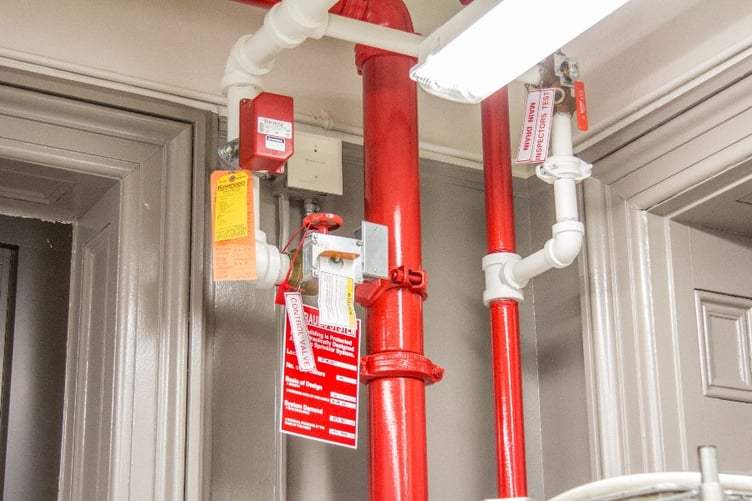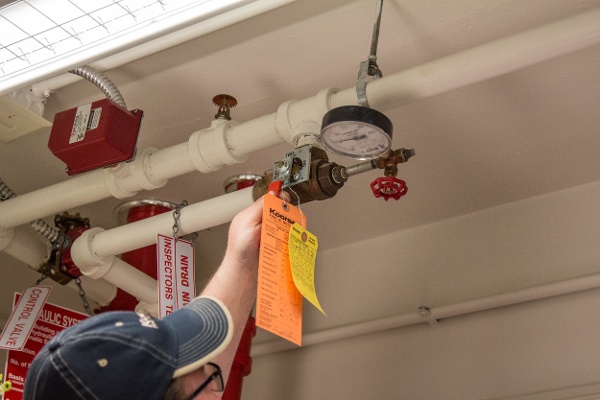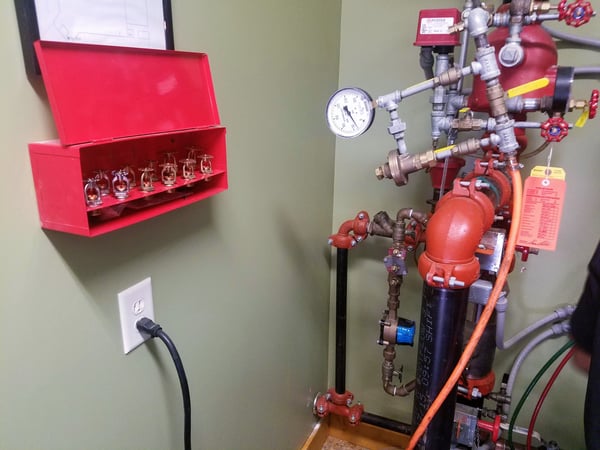
The National Fire Protection Association (NFPA) 13 Standard for the Installation of Sprinkler Systems specifies many different requirements for the types of signage that sprinkler systems must include. The requirements in the Code vary from sign to sign, and their purpose isn’t always immediately clear. What is clear is that they are required for your system to be in compliance with the regulation.
Jeff Beckman, Corporate Training Manager for Koorsen Fire and Security, said that compliance is better when those that own, maintain, and inspect sprinkler systems understand the rationale behind the requirements. For this post, he’ll help “fill in the blanks” by explaining the reasons behind the signs required in NFPA 13, giving you an easy opportunity to take a fresh look at the signs on your sprinkler system to make sure you are in compliance.
Control Valves (Section 6.7.4)
The Requirement – All control valves must have a permanently marked, weatherproof metal or rigid plastic sign secured with corrosion-resistant wire or chain. The sign should provide the following information:
- Indicate valve function
- System being controlled
- Portion of the building served
An additional sign is required for systems that have more than one control valve that must be closed in order to work on the system or space. This sign must indicate that other control valves exist and where they are located.
The Rationale – Beckman explained that knowing which valve controls what part of the building is important to mitigating the extent of water damage after a fire or when a system develops a leak. Signs are also important for testing he said, “If you don’t have a sign to tell you what that valve is, you may mistake it for something it’s not.” He offered as an example, hydrant valves, which are pressurized and always kept closed unless they’re opened by firefighters, “If you don’t know what that valve is for, you’re going to get an unpleasant surprise when you open it.”

Test Connection Valves (Section 6.7.4)
The Requirement – As with other valves, the test connection valve requires a sign to identify it as a test connection. The sign must be made of weatherproof metal or rigid plastic and attached with corrosion-resistant wire or chain.
The Rationale – Beckman said the test connection valve is the only valve that should be closed on a sprinkler system. “The problem is,” he said, “they can often be the same or similar size as the auxiliary drain. The auxiliary drain is used to drain the system and is usually not piped to the outside.” Without a sign indicating the valve is for testing, Beckman said the test connection valve can be easily mistaken for an auxiliary drain.
Antifreeze Sprinkler Systems (Section 7.6)
The Requirement – For antifreeze sprinkler systems, every system riser must have a placard mounted on it to indicate the number and location of any remote antifreeze systems supplied by that riser. On the control valve for the system, a placard is also required to be mounted on the control valve for the system to indicate the:
- Manufacturer, type, and brand of the antifreeze solution
- Concentration by volume of the antifreeze solution used
- Volume of antifreeze solution used in the system.
The Rationale – Beckman said this sign is important for a couple of reasons. One is that sprinkler systems are required to be tested regularly. “You have to know where all of the remote systems are so to make sure they have antifreeze in them. If you miss one or more of them, you can end up with frozen pipes and damaged systems that will fail to function properly when you need them.”
Beckman said another reason is so that you know what kind of antifreeze is in the system. Without the placard on the control valve to indicate the type and concentration of antifreeze required, it’s possible to use the wrong kind. He also noted that it’s not uncommon for antifreeze sprinkler systems to contain insufficient amounts of antifreeze due to either leakage or not being properly refilled after previous maintenance.
Auxiliary Drains on Dry Pipe or Preaction Systems (Section 8.16.2)
The Requirement – The NFPA 13 doesn’t indicate the type of sign required for auxiliary drains, just that it must indicate the number and locations of each drain.
The Rationale – Beckman explained that signs on auxiliary drains are important for dry pipe and preaction systems because they don’t hold water in the sprinkler piping. Instead, the water is held back by a dry-pipe or electronic, preaction valve that, when activated, releases the water into the pipes and through the sprinkler. He said that after an activation, these types of systems have to be drained to prevent the pipes from freezing. “If crews don’t know where all the drains are, they may not get them all drained.”
Fire Department Connections (Section 8.17)
The Requirement – All fire department connections must be outfitted with a plate or fitting with raised or engraved letters at least one-inch tall indicating:
- The type of system the connection serves (the service design)
- If a fire department connection serves only a portion of the building, the sign should indicate what area(s) it serves
- The required pressure for any system that requires 150 pounds per square inch (PSI) or more (the system demand pressure)
The Rationale – Beckman said the reason for this requirement is more obvious than for most other signs. Firefighters need immediate access to your fire department connections, which means they need specific information – obvious, easy-to-read signs that identify where they can connect to your system to get the water they need to extinguish the fire. They also need to know the limitations of the system they’re working with, he said, “A sprinkler system designed to serve a basement of a building won’t help them much if they’re fighting a fire on the roof.”
Hydraulically Designed Systems
The Requirement – Every hydraulically calculated system is required to have a Hydraulic Design Information sign (more commonly known as the Hydraulic Data Plate or Placard). This sign must be located in four places in your system – at the alarm valve, the dry pipe valve, the preaction valve, and the deluge valve. Each sign must be permanently marked, weatherproof metal or rigid plastic sign secured with corrosion resistant wire or chain and are required to include the following information:
- Location of the design area(s)
- Discharge densities over the design area(s)
- Required flow and residual pressure demand at the base of the riser
- Occupancy and commodity classifications
- Maximum permitted storage height and configuration
- Hose stream allowance included
- Sprinkler demand
- Name of the installer
The Rationale – Beckman noted that while most systems installed today are hydraulically designed, there are still a lot of older pipe schedule systems out there. It’s important to know which type you’re working on because each have different requirements for inspection, testing and maintenance.
General Information Sign (Section 25.6)
The Requirement – All sprinkler systems are required to provide a general information sign placed at each system control riser, antifreeze loop, and auxiliary system control valve. This sign must be a permanently marked, weatherproof metal or rigid plastic sign, secured with corrosion-resistant wire or chain and must include all of the following information:
- Name and location of the facility protected
- Occupancy classification
- Commodity classification
- Presence of flammable/combustible liquids
- Presence of hazardous materials
- Encapsulation of pallet loads
- Presence of solid shelving
- Presence of high-piled and/or rack storage
- Maximum height of storage planned
- Presence of other special storage
- Aisle width
- Flow test data
- Location of venting valve
- Location of auxiliary drains and low point drains on dry pipe and preaction systems
- Indication of presence and location of antifreeze or other auxiliary systems
- Name of installing contractor or designer
- Original results of main drain flow test and the dry pipe and double interlock preaction valve test
In cases where injection systems have been installed to treat corrosion, the sign must also include the type and concentration of the chemical used and where information can be found indicating proper disposal methods.
The Rationale – Beckman pointed out that sprinkler system designs vary widely. The general information provided by this sign is very useful for the purposes of ensuring comprehensive inspection, testing, and maintenance so that all requirements of NFPA 25 Standard for the Inspection, Testing, and Maintenance of Water-Based Fire Protection Systems are met.
List of Sprinklers Installed in the Property (Section 6.2.9)
The Requirement – All buildings with sprinkler systems are required to keep a stock of spare sprinklers on the premises along with a list of all the sprinklers installed in the property. This list must be kept in the spare sprinkler cabinet and must include the following information:
- The date the list was issued or revised
- Sprinkler Identification Number (SIN) or the manufacturer, model, orifice, deflector type, thermal sensitivity, and pressure rating for each type of sprinkler installed
- A general description and the quantity of each type of sprinkler to be contained in the cabinet
The Rationale – “This requirement is more important than you might think,” Beckman said. He explained that without specific information regarding the types of sprinklers installed, it’s hard to know what type are in the cabinet and whether they are the right ones. “Often, the sprinklers in the cabinet don’t match those installed or they are just missing altogether. This is a problem because if we don’t have the right sprinklers, the system has to be turned off until we can replace them.”
Koorsen Knows Fire Sprinkler Systems
Koorsen Fire and Security has many factory-trained and certified technicians who, like Beckman, have deep expertise and experience installing, maintaining, and inspecting all types of fire sprinkler systems. We can help make sure you have all the required signage so you can be confident that your sprinkler system is in compliance and isn’t putting your building at greater risk due to missing or incorrect signs. Contact Koorsen today to learn more.



